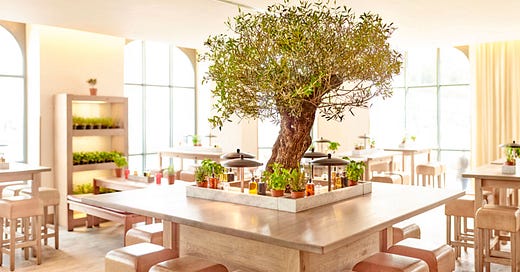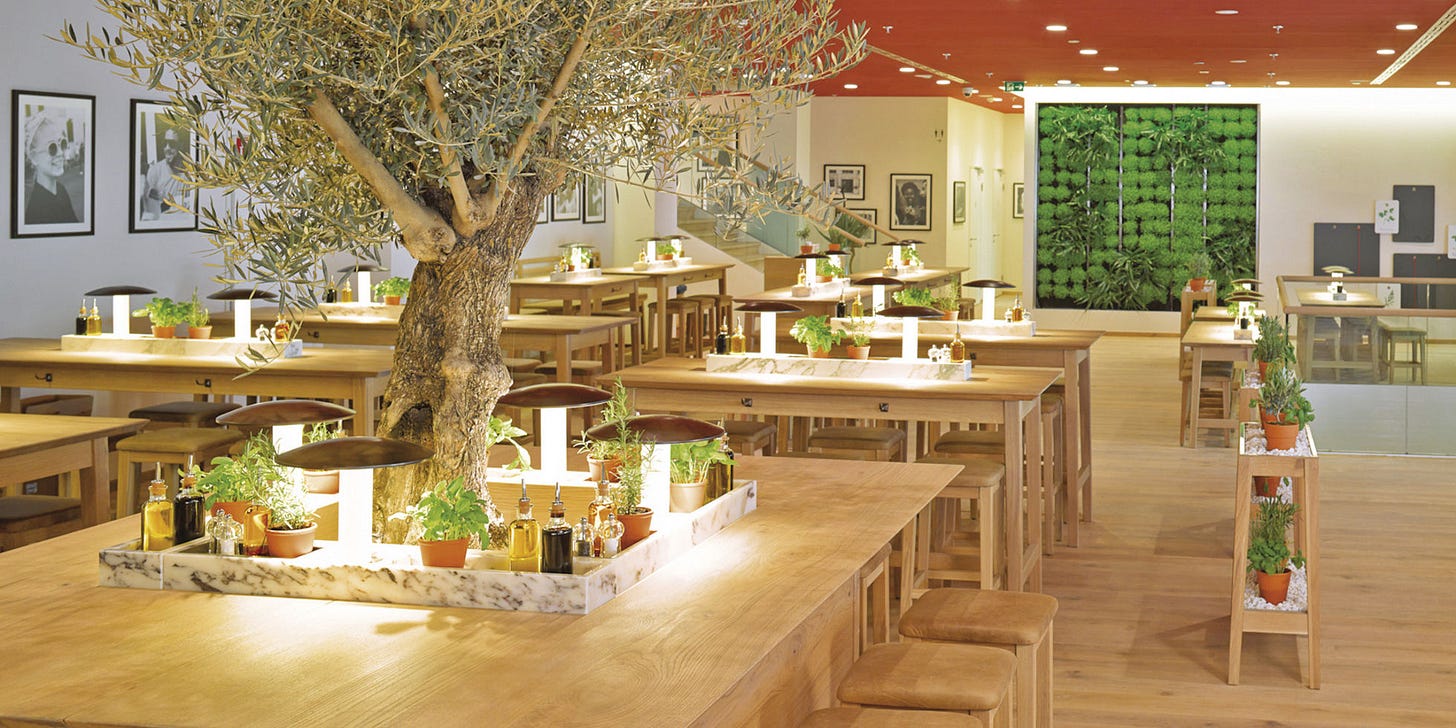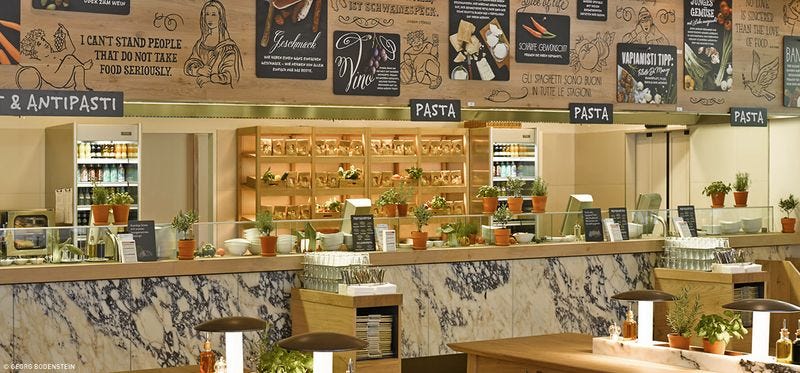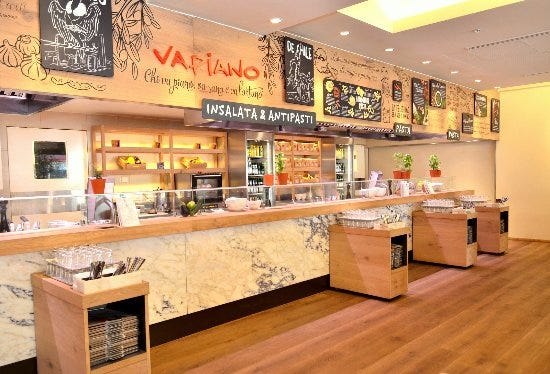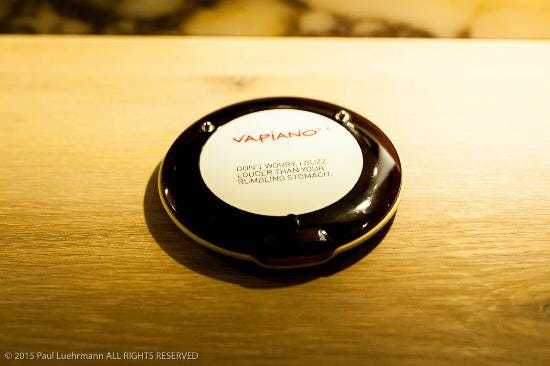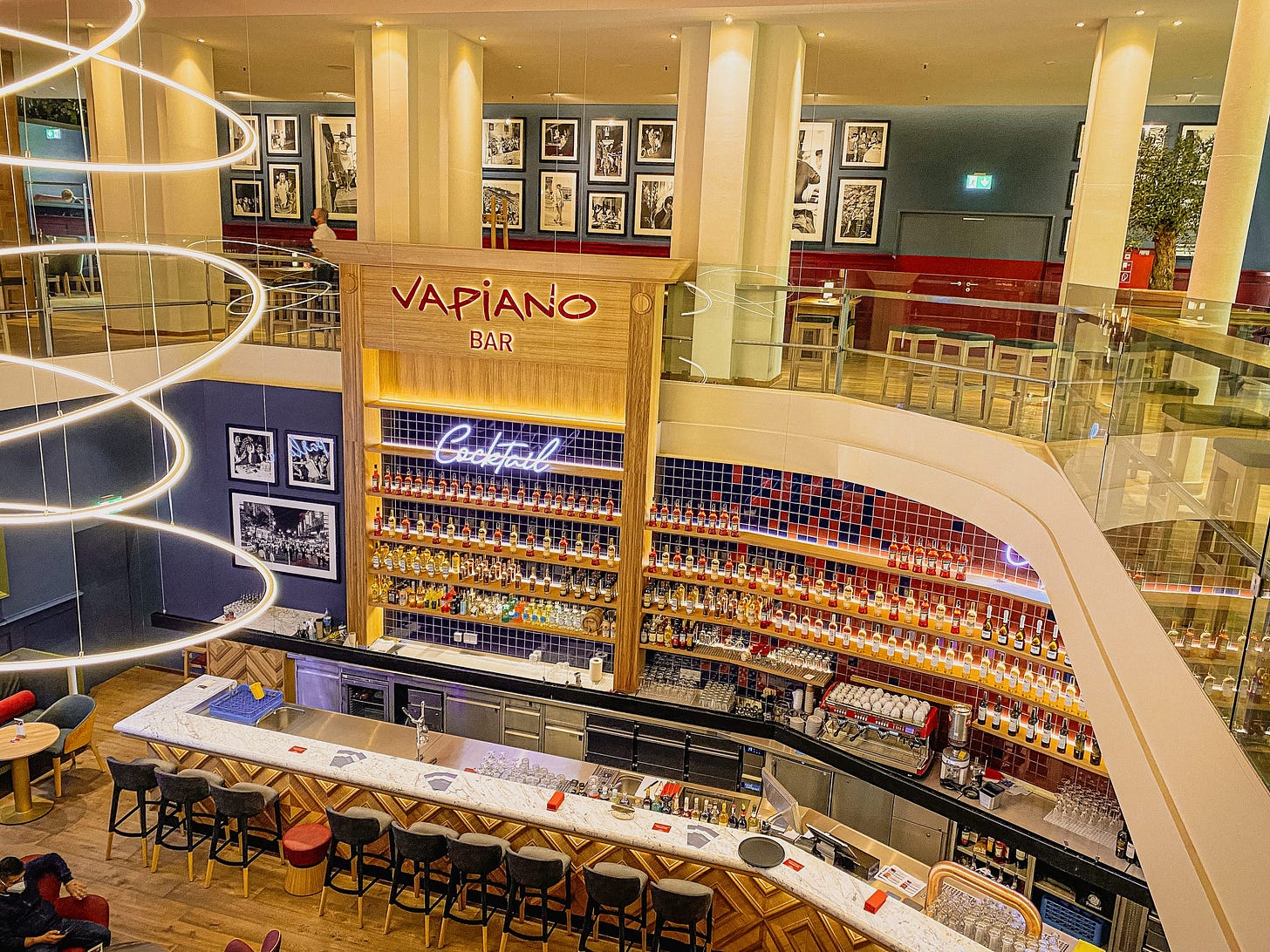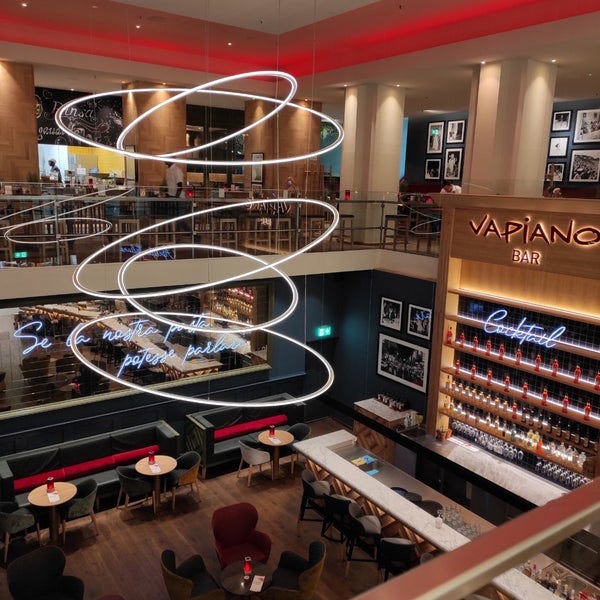The following is an entrepreneurial story about consumer insights, business craftsmanship, big successes and inspiring growth but also major setbacks and mistakes. The product and story we’ll uncover has been created and written in German, yet when we think of German quality products, especially those that are being exported into the world, we tend to think of cars or industrial products. We would hardly think about food, sausages at best. And your intuition would serve you right because this story isn’t about German food, it’ about Italian food – Italian food made in Germany. We are talking about the multinational Italian restaurant chain Vapiano. Today there are 140 Vapiano restaurants spanning across 27 different countries. The chain has undoubtedly shaped the restaurant business landscape in Germany (and Europe) while spawning rivalling successes stories from within.
Setting The Table Scene
Mankind cannot survive without food, that’s simply a law of nature. Surviving without a smartphone? Possible, although I have my doubts sometimes. Surviving without food? A physical impossibility. But by now food has grown beyond its life-given necessity, beyond its evolutionary purpose. Today food brings people together. Friends, family, potential lovers, colleagues, anyone with a mutual interest can come together for a meal. Today, it’s an experience, a form of art and craft and sometimes a lifestyle.
Restaurants are interesting businesses. The market is huge. Everyone must eat; thus, this line of business will never cease to exist. And while its existence being virtually guaranteed regardless of external circumstances, the barriers to entry are low. There are no requirements to pass state exams, develop proprietary technology or amass proprietary information and there are no requirements for large sums of upfront capital investments. For a few hundred bucks, or some equity and debt investment for a larger concept, you can start a hotdog stand in no time and you are in business.
What can be a source of differentiation, the source of survival and success then? There is the physical location, which at extreme and by unconventional, artificial circumstances (think airports / train stations) can actually lead to a monopoly-like position but apart from that the only source of differentiation is the concept. Being first mover and flawless execution are to follow and once you have size, there is scale. Should you be able to execute well for many years, repeatedly, you can start building a brand which can start living in your customer’s mind. You cannot protect yourself with patents or recipes, forget it. So, it is about food, but it’s also so much than about food. Vapiano is the best example. Italian food is not exactly new. Of course, the cuisine itself must have demand but the key differentiating question becomes: are you the freshest; fastest; cheapest; tastiest? Do you provide the best atmosphere, the most fun and what’s the overall experience? Any combination of these attributes as a package makes or breaks the concept. Once you find a winning concept, a hard challenge to complete, you need to be consistent in your execution over and over again. Vapiano has by all measures found a winning concept and has managed to go the next step of successful execution but over time, and that’s what makes this story interesting, its successes would eventually become its biggest burden. Let’s dig in.
How It Begins
We are starting our journey at the Millennia, in Hamburg, Germany. Germany at the time is the third largest economy in the world and people are affluent, with money to spend on eating out. For those reasons Germany is a big and attractive market to fish in for a restaurant entrepreneur. But how can you create differentiated value and more importantly, rather than staying a little bucket shop, how can you capture value as an organization with scale in this business? As with many value capture and commercialization opportunities in the modern past, the first ones to capitalize big on restaurants at scale are the US-Americans. US firms with business ingenuity are the ones coming up with a cookie cutter approach for restaurant expansion. The playbook sounds simple enough. You find a concept that works in one specific region, and once you have done that you copy and paste it across the country. One concept, one recognizable brand, a consistent menu with consistent products and a consistent experience across all sites. You know exactly what you’re getting and paying for, no risks. Local managers and/or entrepreneurs, with selfish/entrepreneurial incentives are then running their own businesses but with a centralized set-up; marketing, distribution, and back-office support functions run by the corporation sitting on top. You’ve got an entrepreneur or manager that can run a proven playbook minimizing his risk of start-up failure as there is proven product-market-fit and execution. While a corporate can rely on the ingenuity, the ambition, and self-interest of an individual on the ground, which this operationally heavy and decentralized business requires. Simple and effective. So, it comes at no surprised that the American fast-food brands, McDonalds, Burger King, and KFC are the first international brands that come to Germany in the 1970s, establishing themselves through the decades as household names. In the 1980 Pizza Hut arrives and in 1999 Subway follows suit. The business rational is clear, you’re tapping into a large, mostly unincumbered and affluent country. What all firms have in common is that they are all fast and fairly cheap, but not necessarily fresh. By the late 1990s there are also Germans chains with market share such as premium stake-house Blockhouse, chicken focused Wienerwald, fish oriented Nordsee, butcher-oriented Zeiss, and smaller and/or regional players such as Movenpick and GOSH SYLT.
Entrepreneurship Is in The Blood
Enter Mark Korzilius. It is the year 1991 and Mark is a freshly baked business school graduate. He’s got multiple job offers from large corporates but turns all of them down and instead decides to start his own business. But like most start-ups the venture fails, and Mark loses a lot of his own money in the porcess. He’d later recall “never start-up with your own money, see if others are willing to fund your idea”. Humbled by the experience he becomes a consultant, however, lingering in the background is the family business, waiting for him to join. The family business, 100+ years old, is an industrial company producing tiles and the family’s natural expectations is that Mark would eventually join. Mark is reluctant and makes it clear to his farther that he wouldn’t join as a “son”. He’d only join if he were to be treated like an external hire with clear responsibilities, executive powers, and terms. Nervously watching Mark increasingly enjoying his consultancy job his father finally decides to approach him with an offer. Mark accepts but three years into the job, he concludes the business isn’t for him and the firm is sold. Being the entrepreneur he is, he immediately ventures into his next project, a flooring business but with little financial success, so that the business is eventually wound down. We are now in the year 2001 and after much consideration Mark decides to go into private banking, after all he’s got the skillset and the networks. He gets results and in early September of 2001 he receives an offer to become a private banker. But as fate would have it, a week later the Twin Towers in New York are hit, and the job offer is off the table. Mark would later recall that failing is part of the entrepreneurial process, it’s painful yes, but you learn and its part of the process. His view is that, and I would agree, in the US failure is seen as the precursor to success, unfortunately Europeans have a different attitude. Upset with the situation he mumbles to himself “screw it, if not banking, I’ll just open up a noodle shop.” He would describe it as a spur of the moment reaction but a woman sitting close to him overhears his mumbling and replies to him “less talk, more action”. The next day he is on his computer, wondering what to do next when he starts going through various restaurant trade journals and boom, eight weeks later a fully-fledged business plan is written up. To revise the plan, he finds a mentor who is so impressed with the proposal that he’s keen to join the venture. That’s great but burned by previous experiences Mark is reluctant to put up his own capital, so he starts looking for investors. Enter Gregor Gerlach, Kent Hahne, Friedemann Findeis and Klaus Rade. All men have one thing in common, they are all former McDonalds people. But beyond that, I am not sure what they’ve put in the water over there, all men involved would go on to become successful businessmen and entrepreneurs in their own right. Gerlach, son of an entrepreneur, a Chicago MBA and ex-McKinsey consultant is a real estate developer, hotelier, and operator of luxury cruises. Hahne, US-born, studied business and computer sciences, was the youngest ever McDonalds franchisee in Germany now owning Apeiron GmbH which operates 15 L’Osteria restaurants and is franchisor of own brands GinYuu, BULLITT and The ASH; he is known as an absolute doer and motivator. Friedemann Findeis and Klaus Rade would go on to start and run the hugely successful L’Osteria restaurant chain that now operates 170 sites across Europe. And finally, Mark Korzilius himself, in 2015 he would start an indoor farming provider &Ever, formerly known as Farmers Cut, which six years later is sold to US listed competitor Kalera for 130 million euros. Clearly there’s some serious business talent assembled here to get Vapiano off the ground.
Vapiano Begins
Vapiano is a simple idea, and the following were great consumer insight that Mark and his fellow associates had. In Germany, there’re Italian restaurant on every street corner because people love pizza, pasta, and salads. Clearly there must be very strong demand for these products, otherwise that many Italian restaurants simply couldn’t survive all at the same time. The food is universally accepted, there are no social classes within past and pizza eaters, there is no age restriction, the elderly like it as much as the kids do. At the same time, Italian food hasn’t changed in over 40 years so why not come up with a new concept, repackage and rejuvenate the Italian kitchen and scale it up. Three themes were important to the founders and investors. First, fresh ingrediencies. This means no ingrediencies or meals are kept warm or microwaved. Fresh ingrediencies, fresh sauces, and even the noodles would be freshly made every single day and to top it off, in fact to show it off, the food would be cooked live in front of the customer.
Second, the atmosphere. Mark hires Mattheo Thun, a prominent Italian designer, and architect who was creative director of Swatch in the early 1990s, who would design “The Hotel of the Year” in 2001, would go on to win multiple awards including the prestigious „Compasso d’Oro“, the Red Dot Awards and Good Design Awards. This guy clearly knows his stuff. Mattheo Thun would put his hand on Vapiano’s design which was expensive for a start-up and very rare amongst the gastronomy industry, but it paid of immensely. All materials used would be highly curated, the colour scheme warm, a cozy bar and lounge area and large oak tables are giving an urban feel-good ambience. The furnishing and interior would reflect a Mediterranean attitude and light colours would provide the place with general lightness. Handwritten recipes are hanging on the wall, there’s a wooden board with interchangeable board elements and a so-called Green Wall, a wall made of plants and herbs. The centrepiece and key recognisable element of every Vapiano restaurant: a living olive tree from Italy.
Thirdly, communication. The place should be vibrant, lively, and modern, the opposite of some of the local boring and stuffy Italian restaurants you would find. When you come in, it should resemble the emotions you receive when you go to a friend’s place, people are happy to see you – hopefully. The atmosphere is warm and inviting at all points during the experience. You don't need a reservation and there is no dress code. You can go in for a spontaneous lunch, a relaxed dinner or for a glass of wine after work.
That was the front end of the concept. One thing that Mark notices during the start-up phase, given his background in the industrials space, is that there are books and sorties written on gastronomy but something like process design or controlling for this line of business is nowhere to be found. He finds out that lots of independent restaurant are even offended when you ask them about good bookkeeping and payroll; many simply don’t have the processing and operational structures in place. Mark doesn’t want to accept that and is keen to implement something similar for Vapiano that was common practise in the industrials space. He approaches different vendors and software providers and quickly realizes the thing he was seeking is common procedure for the US chains, but an independent third-party provider that can plug-and-play is difficult to get.
We are now four weeks away from the grant opening of the first restaurant and there still is no name for the place. Mark is starting to lose his patience; he just doesn’t care anymore and is more concerned about opening on time. All the names the team comes up with are already taken until a friend stops by and tells him to be more Italian and just relax. “Chi va piano va sano e va lontano” he says, which loosely translates to “who goes slow and steady wins.” The name is born. Amusingly, Italian friend and designer Mattheo Thun thinks the name is just stupid. Of course he would, the word concoction has no meaning, but here we are, 20+ years later and the name has stuck.
Then in 2002 after a 1.4 million euros investment in equity and debt, and after much preparation, the f irst Vapiano restaurant finally opens in the city of Hamburg, Germany. The location? “An den Hohen Bleichen”, a dead centre location in Hamburg, an upmarket area, a busy shopping district with many luxury brands close by. It’s between Jungfernstieg on the iconic Lake Binnenalster and the Großneumarkt square, the centre of the Neustadt quarter. It’s the place to be, good action with good footfall.
What’s the experience like? Good prices, fresh and natural ingredients, freshly cooked right in front of you (also known as front-cooking), a good atmosphere with high quality mediterranean fittings and ambiance. When you enter the restaurant, an electronic buzzer and a menu is given to you and you are free to proceed, a new experience at the time. Go sit down, take a seat at the bar or order food straight away. The restaurant layout is designed to break down barriers between kitchen, bar and seating areas for maximum openness and interaction. The aim is to create maximum comfort and cosiness, a place that’s hopefully becoming like your second living room. Once you are ready to order you go over to one of three stations which would prepare past, pizza or salads, respectively and you tell the chef what you want to eat. If you have any special needs or want something altered, you directly communicate with the cook. You essentially become part of the making process which gives you, the customer, a maxim amount of agency and autonomy. It’s worth pointing out that this type of cooking, front-cooking, works well with Italian food as the dishes are generally well known to most, thus directing the chef towards your wishes is intuitive and easy. With something specialised and niche, like an Asian dish on the other hand, most Germans would most likely be overwhelmed. The set up is such that you are free to mix and match different pasta types, which is made in house with the sauces, also made in house. It’s a truly modular approach which enables Vapiano to produce a multitude of variances very flexibly. It’s your choice if you want to stand by the open kitchen, watch your food being prepared or sit down and wait until the buzzer vibrates when your food is ready. There are no waiters, and you pick up the food yourself. Now you can encounter this experience quite often, but at the time this was novel.
To me, the whole setup is somehow reminiscent of a canteen, and I do ask myself why did the canteen format come into existence in the first place? What job does it get done? It’s probably because its fast, in fact hot food is available instantly, and its affordable due to the scale of food being cooked. The downside however is that the food usually isn’t fresh (or tasty), and the fitting and atmosphere is, well, that of a canteen. Vapiano has taken the positive attributes of speed and price and replaces the negative elements with fresh ingredients, meals freshly cooked and a great atmosphere and surrounding to sit in. And boom, you have a winning concept. Corporate employees at lunch and regular visitors in the evenings are equally attracted. From an economics point of view its interesting. The customer carries his or her own food and drinks, for that reason, no waiters are needed. These costs savings can then be passed on to the customer, making the price of the meals more competitive, which in turn attracts more customers.
When the first Vapiano in Hamburg opens it carries 80 seats, attracts around 400 people per day, seven days a week, while the average customer spends 7.80 euros per visit. That’s revenue of over 90,000 euros a month or of 1.1 million euros a year. In the original business plan, management expected 350 guest a day in the second year of operations, but the site becomes so popular so quickly that one and a half years past opening, in the first quarter of 2004, the location attracts 700 guests daily while the average spent per customer increases to 8.60 euros. That means run-rate annual revenue doubles from 1.1 million to 2.2 million euros in the space of less than two years. Impressive. In the years to come, the site never attracts less than 400 guests a day and would spike to 1,123 people and would settle in at an averages of 750 guests a day four years after it first opens. Some stats: The average time spent across all restaurants in the year 2006 is 32 minutes. The concept needs a city with a population of at least 200,000 people and a minimum size of 400 to 600 square meters. The average upfront capital expenditure for a restaurant is between 2,000 and 2,500 euros per square meter.
Interestingly, Mark says that employee retention through philosophy and culture for example is only possible within the higher management ranks. In the lower ranks its very much price driven, boiling down to whether you pay as much as the next guy. He also says that it’s key to be very clear on the concept you are offering. Vapiano tried selling coffee in the mornings, but the customer clearly signalled that Vapiano is a restaurant where you go for lunch and dinner. If the customer wants a coffee, he’ll go into a coffee shop. You can only really sell multiple offerings if your location absolutely allows you to do is, when the customer has almost no choice, like at an airport. The message is clear, focus is key. Remember that lesson as the story unfolds.
There are features to Vapiano’s concept that carry operational and cost benefits to the group that aren’t immediately obvious. Because the food is freshly made the need for large cooling storage facilities and equipment where convenience food is stored on mass and defrosted in response to demand is low. This saves space, equipment, and electricity costs and thus ultimately costs. Given the group’s data driven approach the restaurant can very quickly react to demand using the modular approach (the food is modular) which helps immensely in process controlling. The electronic chip & buzzer allows to collect data on customers’ movements. When does the guest enter; what time does he order his first drink; when does he pick up his food and when does he leave? The electronic chip also helps analyze what the demand is for the various products and specials, and which cook prepared which meal. Vapiano’s introduction of the electronic chip was novel in the industry and the more restaurants there are in the portfolio the more utility the data can provide. In general, and in contrast to many other independent restaurants, Vapiano documents and tracks everything from the front end to the back end of the business.
To be fair, this is nothing new that Vapiano is inventing here, and it has been pioneered by the US incumbents McDonalds, Burger King and the likes. Unfortunately for Vapiano at the beginning, US’ dominance meant that most software providers and vendors were American centric. But the company manages to develop similar capabilities with local players and these capabilities are now part of the group’s success and economic differentiation: the ability to calculate demand, process and track all steps of the process. It’s this process control that allows the company to suck out cost within the process structure which means it doesn’t have to cut costs in precuring high-quality products. And high-quality products in turn help attract and retain more customers. This is a manufacturing business dressed in the clothes of a restaurant. This processing power at the time is a serios competitive advantage versus its independent Italian and none-Italian food competition that heavily relies on gut, spontaneous decision making and less on data and analytics. Mark gives the following example. Some restaurant operators are calling their suppliers every second night looking for discounted products and ingredients they can build into their menu as a dish. The pricing of the final dish is done through gut and guesstimation not by hard, data analytics. If the dish is too cheap, you are leaving margin on the table – pun intended; if the price is too expensive, it leads to leftovers which are subsequently turned into the next day’s special, for which you will knowing the level of demand. As you can see its all freestyle, an approach that makes it harder to drive consistent economics. In contrast to that, Vapiano has a standardised menu, standardised dished, standard recipes with ingredients weighted to the last gram, all accounted and tracked for in the back office, controlled by an exact preparation process which is then taught to the chef/cook. This is why the people who perform the front cooking are easier to train than regular chefs. The steps to deliver a dish are standardized based on the modular approach. During Vapiano’s recruitment process for front kitchen roles communication skills rank higher than cooking skills, the latter being taught within three days. Chefs are more entertainers than cooks and the Vapiano restaurant is their stage. To ensure the menu doesn’t get boring over time, specials are introduced, plus customers can alter their dishes with the chef directly to their liking. Everything is being meticulously tracked and given this level of step by-step process it becomes easier for Vapiano to obtain staff, train employees to perfect each step, increase customer satisfaction and importantly rinse and reap this for each new restaurant that’s being opened, making scaling this business much easier.
Expansion
For the first two years the team around Mark works relentlessly in Hamburg to perfect restaurant operations before doing any expansion. Start-up teams can adopt different approaches here. They can start expanding the second they see there is product-market-fit, thereby fully exploit first mover advantages while figuring the optimal operational processes along the way as you expand and take market share. The downside to this approach is that you may lose customers unnecessarily because the offering wasn’t up to the original standard, jeopardising future success and the venture. Vapiano’s chooses to get things right locally and internally first before tapping into new cities. This approach will serve them well and we shall see what happens once that approach is abandoned. Unfortunately, restaurant chains are not SaaS businesses, where new products or features can be distributed globally through the cloud or where a problem can be fixed over the air at every point equally without delay. Restaurants are local, operationally heavy business and the more units there are the more people are required to enforce certain standard practices and execution is not all homogenous.
But then, in November of 2004, after two years of inception, the moment has finally come, and Vapiano is taking its first expansionary step outside its home turf Hamburg, entering Dusseldorf. Dusseldorf is Germany’s seventh large city by population but with GPD per capita being very high it’s a great location to tap into an affluent customer base. The team choses a top location again, just off Koenigsalle, one of Europe’s prominent luxury shopping miles. While the site in Duesseldorf is being ramped up, the first site in Hamburg is starting to fire on all cylinders, hitting over 2 million euros in sales for the financial year 2004. Things are accelerating from here. Rather than waiting two years for the next expansion, the window is being collapsed to one year and rather than aiming for one opening, the team goes for multiple. Putting the foot on the gas now, the team expands into major German cities Munich, Nuernberg and Frankfurt in 2005. What’s telling about the attractiveness of the concept in the early years of the company is the fact that even in the relatively economically week city of Nuernberg the traffic and average spent per customers is very comparable to sites in the other more affluent cities. For any foreign audience its worth pointing out that unlike many other European countries, like the UK for instance where the London area is extremely economically dominant versus any other region in the country, wealth in Germany is spread out much more evenly amongst cities and regions. This allows, structurally, any chain of restaurants, to find many white spaces to grow into.
I well remember when the first Vapiano opened in Frankfurt in January 2005. It was a big hit, quickly. It was a 400 square meters site, and the place was full. Just like in Hamburg and Dusseldorf, it was an A1 location, right in the city centre, a location with very large footfall. It’s an area where lots of shopping is done and many corporates and financial institutions are located. There is money around and people are willing to spend it. There are 60 members of staff and expectations are high. Between 1,000 and 1,500 daily guests are expected with an average spent of eight to 10 euros per customer. That equates to an expected annual revenue of c. 2.8 million to 5.2 million euros. That’s pretty mind blowing considering this is a single site restaurant. Rent must have been a fortune though. One real estate report I found from the year 2003/2004 indicates that office space in that area was around 28 euros per square meter. That would mean a monthly lease bill of 11,200 euros and c. 135,000 euros annually. But given the lower bound revenue expectation was 2.8 million euros, that makes rent charges as proportion of revenue less than 5%, which is exceptionally good for any restaurant location. In Vapiano’s 2008 annual report, the company discloses the actual monthly rent charge for that Frankfurt site which was 13,507 euros per month, c. 20% higher than my guestimate for the year 2005. It’s not clear whether the site’s rent is tied to revenue or inflation but even if we assume the rent to be equal in 2005 to the one in 2008, which is unlikely but nevertheless, it still would have only accounted for c. 6% of annual revenue on the lower bound and c.3% on the higher revenue bound. Still, exceptionally good numbers.
Four months after Frankfurt’s opening, in April of 2005, a new location in Munich opens up. A prime, high-end location in Fünf Höfen, a shopping mall in the centre of Munich. It’s more than double the size of Frankfurt’s location with 1,000 square meters and is without a doubt the classiest self-pick up, self-serving restaurant of the city. For the grand opening a list of local celebrities are invited to juice up the brand. But the big novus in strategic step is the fact that it’s the group’s first franchise site. The first sites in Hamburg, Dusseldorf and Frankfurt are all company owned and managed. Munich is different, ownership and operations, and therefore control to a degree over processes and the brand, for the very first time is given to an external party. For the grant opening local franchisee Dominik Boxler says: “We offer our guests the best quality in the best location, but at a low price.” True. Prices ranged from five to eight euros per meal, unbelieve in today’s post-covid price inflated environment. The site averages 1,500 guest a day with an average spent of 10 euros a guest, which equates to roughly five million euros in annual revenue. Huge.
Let’s do some rough, back of the envelope, calculation to get a feel for the economics of the business. The opening costs per site in the years 2005/2006 are between 0.9 and 1.5 million euros. As pointed out earlier, between 2,000 to 2,500 euros per square meters. The average spent per customer just under 10 euros, each site carries between 600 and 1,500 guest a day and the restaurants are open every day of the week. If the average revenue per site is around 3 million euros with operating margins of 20% (can be much higher), that’s 600,000 euros of earnings before interest and tax on an initial capital outlay of 1.2 million euros. That’s a 50% return on invested capital. These are beautiful economics.
Not only is the year 2005 the first year of major expansion it’s also the first year for the company to cross the 10 million euros revenue mark, a major milestone and proof that the Vapiano concept has absolutely hit product-market-fit. Just one year later, in 2006, the company hits another major milestone and starts expanding internationally for the first time. Sites in Belgium, Turkey, and Austria are opened. I am not sure why it was necessary so early in the company’s history to go abroad before fully penetrating Germany first. Regardless, Mirko Silz is now taking over as the CEO and he will stay in that role until 2011. Eventually Mirko would become one of three managing directors at fierce competitor, Italian pizza & pasta restaurant chain L'Osteria.
This following part is quite delicious – pun intended. In 2006 Vapiano, this new little German start-up is so successful that US behemoth McDonalds feels threatened and sends out a memo to its own franchisees warning them, that if there were to be negotiating with Vapiano on a franchise license, they would immediately lose their concessions with McDonalds. Wow. I am not sure you can get a better stamp of approval than this. Vapiano of course couldn’t be happier about McDonald’s “endorsement” as it was free advertisement and a clear positive signal to any perspective restaurant entrepreneurs looking for opportunities, sending talent Vapiano’s way. The team has done a fantastic job building this business and in 2006 Vapiano is absolutely competitive with McDonalds with regards to average revenue and profitability. A well operated Vapiano restaurant can generate 25% to 28% operating profit at the restaurant level. These are beautiful margins for any type of business regardless of the industry. And we are not talking about a little bucket shop hot dog stand doing a couple of thousand bucks in revenue, these margins are made on multiple millions of euros in turnover. This of course requires absolute process control, being open seven days a week and managers being on top of their game, paying close attention to every detail. But if you do get things right, for a single site that makes 3 million euros in annual revenue, that’s between 750,000 and 840,000 euros of profits before interest and taxes awaiting the owner’s pocket. No doubt these types of economic will attract some talent.
In 2006, every restaurant produces between 80 and 120 kilograms of fresh noodles in house, every morning between nine and 12. Pasta and salads are the major revenue drivers, on the beverages side it’s water, Coca-Cola being a close second. Just as a fun side note, the customer is actively asking for the Coca-Cola brand, that’s how powerful the Coke brand has become over the decades and not stocking Coca-Cola is simply not an option. Tipping my hat here to Warren Buffett. Most readers probably don’t know this, but restaurants are buying Coca-Cola through wholesalers at prices that are higher than those that any private consumer is paying at retail. Now that’s what a call pricing power.
That year the company's annual net revenue explodes to 24.5 million euros. CEO Mirko Silz says he wants to achieve a 50:50 ratio split between self-operated and franchised restaurant going forward as the current portfolio is too dominated by franchise-operated locations. Looking at the economics of the restaurants I can see the lure, but they are operationally intense businesses. The expansion train continues with full steam ahead in the years 2007 and 2008 with multiple own-operated and franchise sites being opened. By the end of 2007, 13 franchise licenses in Germany are given and more in Sweden, Belgium, the Netherlands, Austria and Switzerland. The company also starts to densify within already present cities. Hamburg would have its third site, Vianna its second. Group revenue in the year 2007 grows to over 30 million euros and operating profits reach 3.6 million. This includes all self operated and owned revenue and revenues from franchisees fees. The franchise fee is a 6% revenue fee per restaurant, plus a 1% revenue fee for group marketing. Noticeably the operating profit of the group or EBIT (Earnings before interest and taxes) is only 11.9% of total revenue, a far cry from the restaurant level EBIT of 20%+ that can be achieved. Firstly, the group needs to carry overhead costs that the individual restaurants don’t have or only partially, like regional managers, central support functions, property scouting, procurement, recruitment and assessment, marketing, legal, etc. Secondly the group is aggressively expanding, which needs additional functions and new-opening costs, alongside other charges that wouldn’t occur in a stand-still situation. The group’s free cashflow, a figure indicating how much actual cash the group generates for its owners after all expenses including interest, taxes and capital expenditures (capex) are made, is significantly negative that year due to the aggressive growth of the group. Over seven million euros is spent on capex, that is on opening new restaurants and maintaining the existing base. The cash flows from the operations of the business are not enough to cover these investments so that the company has to resort to debt. By the year end of 2007, the company has about 9 million euros of debt outstanding. While that may sound large, it’s only roughly 2.5 years’ worth of profits before taxes, which is fine. Just to give you a comparison, in real estate, it’s very common to have debt that exceeds 10 times or significantly more the yearly rental income of a property, although the risk profile might be different.
This will be the beginning of debt induced growth rocket. We are just about to take off.
To be continued.

